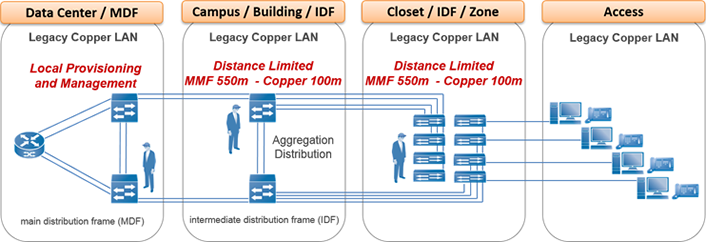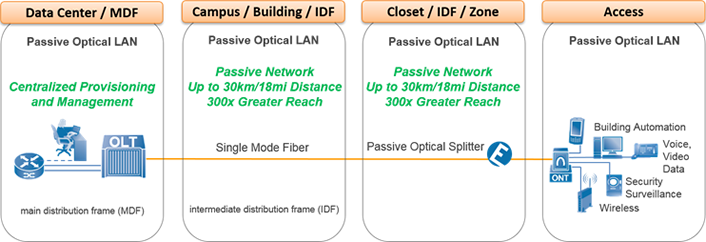From its initial role in improving logistics and inventory management to its now nearly ubiquitous presence in a variety of industries, the Internet of Things (IoT) has greatly influenced our day-to-day lives. And with all the opportunity surrounding IoT applications, this trend shows no signs of slowing down any time soon.
A recent Gartner report predicts the total amount of connected devices will reach 20 billion by 2020. This means that in less than four years, the number of connected gadgets and products will be three times greater than the Earth's current population.
Higher education, like nearly every other business in the world, will continue to be transformed by IoT. Smart building management tools will remotely control lights and HVAC across different buildings. Enhanced security features with automated lockdown and notification settings will better protect everyone on campus, and even tracking student attendance will become more efficient.
These developments mean that, on top of delivering basic connectivity for students, faculty members, and staff, higher education network infrastructures will also have to ratchet up their bandwidth capabilities to integrate the numerous new smart devices and systems that come along with the IoT.
With this tidal wave of change, now is the time to discuss how higher education institutions should tackle their growing connectivity needs.
Traditional copper-based local area networks (LANs) have served as the in-building network technology backbone on campuses for decades. That worked in the early days of connectivity; however, nowadays there is a problem with this approach. Simply put, in order to accommodate higher education's growing IoT connectivity needs, these networks will require extensive high-priced and laborious upgrades.
Instead of dedicating time and resources upgrading networks with antiquated copper-based technology, there is an alternative backbone network infrastructure that better fits any higher education campus — passive optical LAN. Both from a technological and cost-saving standpoint, this technology is better structured to handle the needs of IoT and can do it at a fraction of the cost required to make copper-based LANs work.
The IBM Global Technology white paper "Smarter Networks with Passive Optical LANs" estimates passive optical LAN's capital cost savings at 46 percent and the operational cost savings at 58 percent compared to traditional copper-based LANs. The same IBM study placed intermediate distribution field (IDF) floor savings at 90 percent, and power and cooling savings at 81 percent.
The following is a detailed breakdown on the differences between the passive optical LAN and copper-based LAN.
Passive Optical LAN Compared to Copper-Based LAN
A legacy copper-based LAN typically offers fixed point-to-point connectivity via a hierarchy of racked and stacked workgroup Ethernet switches in a main data center and telecommunications rooms across a campus. To deliver some degree of reliability, that hierarchy adds an even more tangled mesh of copper cabling. This cumbersome wiring is hindered by the reach of a legacy LAN's service delivery, which is limited to 100 meters for copper and 550 meters for multimode fiber (MMF) cabling. Because signal regeneration must travel longer distances with this dated infrastructure, there's a need for more aggregation, distribution, and telecom rooms filled with racks and stacks of additional Ethernet switches. These telecom rooms are stuffed not only with the Ethernet switches but also with UPS, A/C, ventilation, and fire-suppression equipment. All of this results in high costs to build, operate, maintain, and upgrade these complicated rooms (see figure 1).

* MDF = main distribution field
Figure 1. Legacy copper LAN architecture
This old-school framework is heavily burdened throughout all elements of its structure. As a result, all Ethernet ports from the core router to the workgroup switch struggle to maintain full functionality. Its point-to-point architecture requires lots of painstaking and expensive work to deploy and maintain.
In contrast, passive optical LANs offer a more elegant construction with significantly greater density gigabit Ethernet endpoints than the copper option. Passive optical LANs also occupy a much smaller footprint due to a shared infrastructure that better mimics modern cloud and wireless architecture by centralizing the network management in one location.
Passive optical LANs feature shared point-to-multipoint architecture, passive optical distribution infrastructure, and near-future-proof single-mode fiber (SMF) connectivity. While copper-based cable has well-established capacity limitations (e.g. 1G, 10G, 40G), fiber has no known similar limitations. Today, fiber capacity is measured in terabits, where copper cabling is measured in gigabits. This enables college and university IT facilities to better support current and future growth demands for voice, video, data, wireless, security, building automation, and other IoT endpoints.
This architecture shifts network intelligence to the core and centralizes the management of all far-reaching endpoints. Just as cloud-based computing and wireless networks consolidate resources for sharing by many users — a setup that saves energy, space, capital costs, and operational costs — an optical LAN does precisely the same thing. Passive optical LAN architecture centrally locates the optical line terminal (OLT) in the enterprise data center (see figure 2).

Figure 2. Passive optical LAN architecture
Benefits for IoT and Higher Education
Passive optical LANs' two main benefits when it comes to IoT demands — especially those at higher education institutions — are scalability through simplicity and the use of fiber optic cables.
Scalability through Simplicity
Passive optical LANs can handle the growing impact of IoT at colleges and universities because of their ability to serve 8,000-gigabit Ethernet endpoints across a 30-kilometer reach from one system (for example, the OLT). This architecture reduces operating costs thanks to fewer electronics, less cabling, lower power needs, and a reduction (or even elimination) of telecom rooms. With its centralized intelligence and network management, this fiber-based solution requires fewer IT resources to maintain and increase campus-wide services.
Fiber Optic Cable Superiority
Compared to a CATx copper cable, single-mode fiber (SMF) is smaller, lighter, and stronger; has a tighter bend radius, higher bandwidth capacity, and longer reach; is less susceptible to electromagnetic interference (EMI); boasts faster connector solutions and longer life; and, with lower material cost than CATx, is comparatively less expensive. The IBM Global Technology white paper showcases how CAT6a copper-cabling weighs four times more, introduces 50 percent extra plastics into the building, and costs an additional 46 percent to install compared to SMF cabling.
Fiber cabling and passive optical LANs provide the capacity to converge all network services, thereby eliminating the need for multiple platforms and cabling infrastructure. At the same time, the architecture offers exceedingly scalable high-speed data services to all campus users. In addition, by choosing fiber cabling, the campus IT staff gains a graceful path forward for future 10-gigabit Ethernet speeds and the next generation of wireless technology, since today's passive optical network standards allow for future 10G-PON and 40G-PON to coexist over the same fiber with no wavelength conflicts.
Technology That Moves Higher Education Forward
Throughout the world, higher education officials are contemplating their growing connectivity needs, as the IoT becomes an increasingly important variable on their campuses. While modernizing existing legacy copper-based LANs seems a valid option, the costs and staff time required for this upgrade strongly suggest otherwise. Passive optical LANs offer a better alternative. This network architecture helps meet rising connectivity demands by shoring up interior IT facility infrastructures and by gaining three advantages compared to legacy copper infrastructure: network simplicity, network scalability, and cabling superiority.
By installing passive optical LANs, higher education IT departments can realize significantly greater density gigabit Ethernet endpoints for IoT while occupying a much smaller footprint. This allows facility infrastructures to support current and future IoT demands for voice, video, data, wireless, security, campus environmental, campus automation, and all other IoT endpoints. Transitioning to a passive optical LAN will assure campuses everywhere infrastructures ready for the inevitable IoT transformation.
John Hoover is APOLAN Marketing Committee chair and Tellabs senior product manager.
© 2016 John Hoover. This EDUCAUSE Review blog is licensed under Creative Commons BY-NC-ND 4.0 International.
